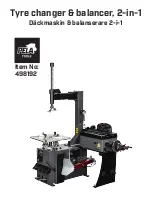
4. Place tire over wheel and move swing arm into position
making sure the valve stem is at the 9 o’clock position in
front of bead lock. Position tire so that lower bead is above
the rear extension of the mount/demount tool and below the
front knob (figure 17).
Figure 17 - Position Tire Against (Mount/Demount Tool)
5. Depress table top pedal and rotate wheel to mount lower
bead. Use drop center of wheel by forcing down on tire just
ahead of the mounting tool, and follow as tire rotates. Rotate
table top until lower bead is mounted.
6. For top bead installation, rotate the table top until the valve
stem is directly across from the mount head. Lift the upper
bead up and over the rear of the mount head. With your left
hand press down on the tire between the mount head and the
valve stem to hold the tire in the drop center. Depress table top
pedal and rotate tire until bead is mounted. Be careful to en-
sure bead stays in the rim drop center in the area ahead of
Mounting head (figure 18).
Figure 18 - Mounting Top Bead
N.
If table top rotation stalls, reverse the table top mo-
mentarily until tire bead is again loose on the wheel. Reposi-
tion tire on Mounting head, make sure bead is correctly posi-
tioned in drop center of the wheel; then attempt mounting
again.
P.
For low profile or stiff sidewall tires, it may be ad-
vantageous to use the bead lifting tool to initially hold the
upper bead down in the drop center.
R.
For tube type tires, mount lower bead first, move
swing arm out, install tube, and then mount upper bead.
(9) Inflation
Tire inflation is performed in three steps: BEAD SEAL,
BEAD SEAT, and INFLATION. These steps are ex-
plained in detail on page 12. Read the explanation of each
step and understand them thoroughly before proceeding.
The inflation pedal, located at the rear of the left side of the
machine, controls the flow of air through the inflation hose,
and has three positions.
Note:
The clip-on chuck on the end
of the hose should always be an open/freeflow style with all
parts in proper working order.
Position 1 - Tire Pressure –
With the inflation hose
attached to the tire valve and the pedal in this position, the
air gauge will register the air pressure in the tire. Whenever
your foot is removed from the pedal, it will return to this
position.
Position 2 - Tire Inflation –
This is the first activated
position. With the inflation hose attached to the tire valve
and the pedal in this position, line pressure is allowed to
flow through the valve system and into the tire for inflation.
Correct tire pressure is not indicated on the gauge in this
position.
Position 3 - Bead Sealing –
This is the second and last
activated position. With the inflation hose attached to the
tire valve and the pedal in this position, line pressure is
allowed to flow through the valve and to the airflate bead
seal jets on the table top for bead sealing.
1. If the rim has been clamped from the outside for
tire mounting, release the clamps, lift the tire, and move
the clamps to the center of the table top.
Note the Inflation Pedal Positions
(See Diagram)




















